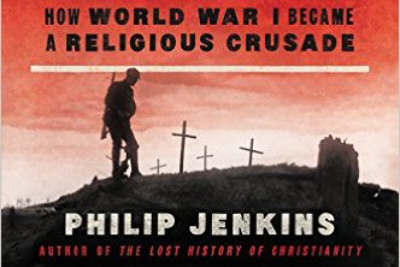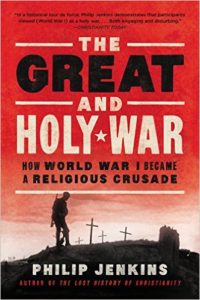
Book Review: The Great and Holy War
 The Great and Holy War: How World War I Became a Religious Crusade, by Philip Jenkins, copyright 2014. ISBN 978-0-06-210509-7, 438 pages, four stars.
The Great and Holy War: How World War I Became a Religious Crusade, by Philip Jenkins, copyright 2014. ISBN 978-0-06-210509-7, 438 pages, four stars.
Living in the secular west, most of the information that I encounter on the Great War is entirely secular in nature. Descriptions of battles, assessments of strategies, even the consequences of the war have been described without any mention of the role of religion. Could it be, however, that our secular outlook on life has falsely colored our view of the Great War? Could it be that this defining conflict of the 20th century was drenched in religious themes and motives? The Great and Holy War: How World War I Became a Religious Crusade, by Philip Jenkins, gives this side of the story.
Jenkin’s purpose is to give an overview of the religious side of the war. He reveals how religious fervor supported the war and encouraged believers to join the war effort. He also describes religion at the time of the Great War, both on the home front and in the trenches. As Jenkins points out, Europe was far from a secular continent at the outbreak of the war. “Contrary to secular legend, religious and supernatural themes pervaded the rhetoric surrounding the war – on all sides – and these clearly had a popular appeal far beyond the statements of official church leaders. If the war represented the historic triumph of modernity, the rise of countries “ruled by scientific principles,” then that modernity included copious lashings of the religious, mystical, millenarian, and even magical” (page 4).
Eventually, Jenkins goes into a description of the effects of the war on religion, which he sums up when he says, “not only did the war not kill religion, it actually revived some faiths – even if the specific forms they took might alarm many Westerners” (page 367). Jenkins goes about this task by surveying a number of themes. He describes the crusader and religious rhetoric used by government and religious leaders, describes the war’s relationship with conventional views of the apocalypse and Armageddon, and delves into the effect of the war on European Christianity (which resulted in disenchantment with German liberal theology and the rise of such men as Karl Barth), Judaism (greater hopes for a Palestinian homeland even as views on racial superiority prepared the way for Nazism), Worldwide Christianity (the rise of African and Charismatic forms, and Catholic responses to the conflict), and Islam (the end of the caliphate, a redefinition of Islam, and the rise of radical forms of the faith).
I found The Great and Holy War to be an effective, interesting, and enlightening survey of religion during and after the Great War. As the book points out, the conflict had profound effects on the religious history of the world, even though most people would be hard pressed to identify those effects. Jenkins notes that the shock waves from a catastrophe on the scale of the Great War cannot be properly understand until decades, even generations later. This book, looking back one hundred years, seeks to identify those shock waves and their effect on our modern world.
Such a profound task requires a qualified scholar, and Forbes said, “Jenkins is one of America’s top religious scholars.” Fortunately, while many religious scholars are strongly biased, I was unable to determine the author’s religious perspective and did not note any preference for or against Christianity or secularization. While it is impossible for anyone to write a one-book survey of such a broad topic and remain thorough, The Great and Holy War accomplishes its of goal of surveying the situation quite well, especially since it delves into not only the Western religious atmosphere, but also the Eastern and African settings.
Books like The Great and Holy War are valuable to modern readers because they reveal to us the underground structure of our modern society, showing the forces that welded and molded the 21st century into the form that it holds today. Anyone interested in understanding religion in the 21st century would benefit from this book, as well as those who are interested in understanding the effects of World War One. With such a broad survey of the war, this book provides powerful illustrations to pastors and Bible teachers about religion, modern war, and what happens when these two subjects are combined. In the end, The Great and Holy War is less about recounting religion in 1914, and more about revealing the effect of 1914 on religion in 2014.



